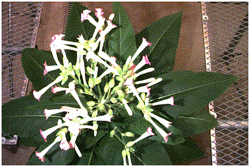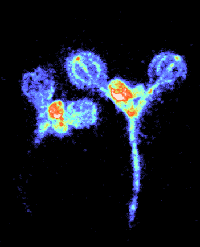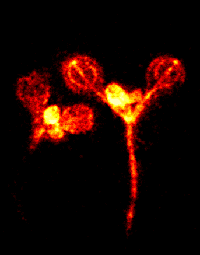
CLOCKS IN OTHER ORGANISMS..page 2
Plants
Charles Darwin is probably most famous for his ideas on evolution
through natural selection. In his later years, he became fascinated with
plant movements while trying to find an evolutionary relationship among
them. He did hundreds of experiments to keep track of the movements of
the different varieties of plant leaves. After experimenting, Darwin
concluded that the plants were moving their leaves so as to expose the
smallest possible leaf surface to the night temperatures. His book,The
Power of Movements in Plants details the years of work. In the years
following, scientists would debate whether the rhythm arose from forces external to the plant
or was endogenous.
 In 1920, a landmark paper was written by W.W. Garner and H.A.
Allard in which they showed that tobacco plants would flower only if
exposed to a certain number of hours of light. The term "photoperiodism"
was used to designate the response of the organisms to relative length of
day and night. Garner and Allard showed that plants could tell time! The
ability to sense day length is an important ability for plants so that they
grow, reproduce and develop during favorable time of the year. The
changing times of dawn and dusk contain seasonal information as well as
time of day information so that the organisms have, in effect, an internal
clock and calendar[23].
In 1920, a landmark paper was written by W.W. Garner and H.A.
Allard in which they showed that tobacco plants would flower only if
exposed to a certain number of hours of light. The term "photoperiodism"
was used to designate the response of the organisms to relative length of
day and night. Garner and Allard showed that plants could tell time! The
ability to sense day length is an important ability for plants so that they
grow, reproduce and develop during favorable time of the year. The
changing times of dawn and dusk contain seasonal information as well as
time of day information so that the organisms have, in effect, an internal
clock and calendar[23].
In plants a photoperiodic clock not only controls flowering, but also
induction and termination of dormancy in buds and bulbs, seed
germination, and daily rhythms such as leaf movements, petal movements,
and nectar secretion.
 In more recent experiments with plants, Steve Kay et al have developed an
interesting technique to measure rhythms in Arabodopsis thaliana . The researchers chose this plant
for many reasons including its small size, short life cycle, and number of chromosomes (n=5).
As a way to measure rhythmic gene expression in vivo in these plants, they
transplanted firefly luciferase gene (which is responsible for the
insect's glow) into the plants. The plants exhibited rhythms in bioluminescense
when their CAB genes (CAB is a light harvesting protein) were being "turned
on" rhythmically. In other words, the luciferase gene was used as an intra-cellular
marker to detect the plants' own gene activity
In more recent experiments with plants, Steve Kay et al have developed an
interesting technique to measure rhythms in Arabodopsis thaliana . The researchers chose this plant
for many reasons including its small size, short life cycle, and number of chromosomes (n=5).
As a way to measure rhythmic gene expression in vivo in these plants, they
transplanted firefly luciferase gene (which is responsible for the
insect's glow) into the plants. The plants exhibited rhythms in bioluminescense
when their CAB genes (CAB is a light harvesting protein) were being "turned
on" rhythmically. In other words, the luciferase gene was used as an intra-cellular
marker to detect the plants' own gene activity  rhythms[27].
In other experiments, they isolated and cloned a photoreceptor gene from
rice. Multiple copies of this phytochrome gene were transplanted to tobacco
with the result that the tobacco plants became hypersenstive to light because
of the higher than normal number of photoreceptors[28]. Scientists are
attempting to do a similar experiment with rice in the hope that they will
be able to grow rice under low-light conditions and produce more crops per
year.
rhythms[27].
In other experiments, they isolated and cloned a photoreceptor gene from
rice. Multiple copies of this phytochrome gene were transplanted to tobacco
with the result that the tobacco plants became hypersenstive to light because
of the higher than normal number of photoreceptors[28]. Scientists are
attempting to do a similar experiment with rice in the hope that they will
be able to grow rice under low-light conditions and produce more crops per
year.

Accessibility statement
 In 1920, a landmark paper was written by W.W. Garner and H.A.
Allard in which they showed that tobacco plants would flower only if
exposed to a certain number of hours of light. The term "photoperiodism"
was used to designate the response of the organisms to relative length of
day and night. Garner and Allard showed that plants could tell time! The
ability to sense day length is an important ability for plants so that they
grow, reproduce and develop during favorable time of the year. The
changing times of dawn and dusk contain seasonal information as well as
time of day information so that the organisms have, in effect, an internal
clock and calendar[23].
In 1920, a landmark paper was written by W.W. Garner and H.A.
Allard in which they showed that tobacco plants would flower only if
exposed to a certain number of hours of light. The term "photoperiodism"
was used to designate the response of the organisms to relative length of
day and night. Garner and Allard showed that plants could tell time! The
ability to sense day length is an important ability for plants so that they
grow, reproduce and develop during favorable time of the year. The
changing times of dawn and dusk contain seasonal information as well as
time of day information so that the organisms have, in effect, an internal
clock and calendar[23].
 In more recent experiments with plants, Steve Kay et al have developed an
interesting technique to measure rhythms in Arabodopsis thaliana . The researchers chose this plant
for many reasons including its small size, short life cycle, and number of chromosomes (n=5).
As a way to measure rhythmic gene expression in vivo in these plants, they
transplanted firefly luciferase gene (which is responsible for the
insect's glow) into the plants. The plants exhibited rhythms in bioluminescense
when their CAB genes (CAB is a light harvesting protein) were being "turned
on" rhythmically. In other words, the luciferase gene was used as an intra-cellular
marker to detect the plants' own gene activity
In more recent experiments with plants, Steve Kay et al have developed an
interesting technique to measure rhythms in Arabodopsis thaliana . The researchers chose this plant
for many reasons including its small size, short life cycle, and number of chromosomes (n=5).
As a way to measure rhythmic gene expression in vivo in these plants, they
transplanted firefly luciferase gene (which is responsible for the
insect's glow) into the plants. The plants exhibited rhythms in bioluminescense
when their CAB genes (CAB is a light harvesting protein) were being "turned
on" rhythmically. In other words, the luciferase gene was used as an intra-cellular
marker to detect the plants' own gene activity  rhythms[27].
In other experiments, they isolated and cloned a photoreceptor gene from
rice. Multiple copies of this phytochrome gene were transplanted to tobacco
with the result that the tobacco plants became hypersenstive to light because
of the higher than normal number of photoreceptors[28]. Scientists are
attempting to do a similar experiment with rice in the hope that they will
be able to grow rice under low-light conditions and produce more crops per
year.
rhythms[27].
In other experiments, they isolated and cloned a photoreceptor gene from
rice. Multiple copies of this phytochrome gene were transplanted to tobacco
with the result that the tobacco plants became hypersenstive to light because
of the higher than normal number of photoreceptors[28]. Scientists are
attempting to do a similar experiment with rice in the hope that they will
be able to grow rice under low-light conditions and produce more crops per
year.